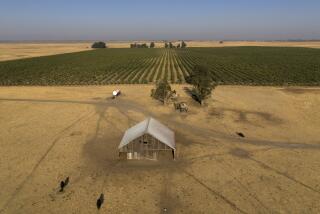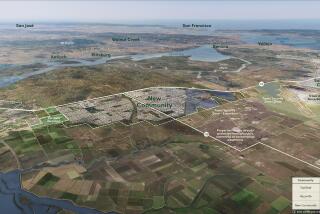Biologist Says Laguna Cattle Should Vamoose : Environment: Canyon cattle are incompatible with goal of allowing native vegetation to reclaim its turf, Greenbelt official says. A businessman disagrees.
LAGUNA BEACH — If Elisabeth Brown has anything to say about it, the cows won’t be coming home to Laguna Canyon Road next year. To be sure, she’d like to see them moo-ved elsewhere.
Brown, a biologist and environmentalist, says the constantly munching cattle are incompatible with long-term environmental goals for the land, including allowing the native grass and coastal sage scrub to reclaim the turf.
On Tuesday, Brown will present her case to the City Council, which will soon consider whether to extend an agreement allowing the cattle to graze on about 750 acres of canyon grassland. The agreement expires in June.
“I think a lot of people are attached to the cattle because it was (cattle) or development,” said Brown, president of the environmental group Laguna Greenbelt and one of four members of the Coastal Greenbelt Authority, a group formed to provide long-term management for the land. “But we’re getting past that. When the cattle leave, it won’t be because the bulldozers are going to follow.”
But Fred Hendeles, a Los Angeles businessman who leases the property from the Irvine Co. for grazing, said the cattle should be allowed to roam, at least until the land is needed for another purpose.
“As long as they don’t do any specific thing with the land, I can’t see why they don’t let the cows eat up the grass,” said Hendeles, who employs one full-time cowhand to tend to the more than 600 cattle on the property.
The land in question, which includes three natural lakes, is part of a massive open-space parcel that is being set aside as a wilderness park. The property is owned in part by the city and in part by the Irvine Co. Although the Irvine Co. officially holds the lease on the grazing land, the city--which earns about $8,000 a year as part of the lease agreement, according to Deputy City Manager Rob Clark--must agree to the contract with Hendeles.
If the contract is not renewed, Hendeles said, it will mean the end of part of his business and the end altogether for the bovines.
“We have to place them someplace or we’ve got to kill them,” said Hendeles, who also operates several other cattle ranches in the state. “It’s a big problem. What can you do?”
The cattle, however, may still get a reprieve.
A staff report submitted to the City Council lists several reasons why officials may want to allow continued grazing in some areas of Laguna Canyon, apart from the financial considerations. Among them is a statement that the cattle are “part of the historical character of the canyon” and that grazing reduces the risk of fire. In some areas, the city has brought in goats to nibble away dry brush.
Brown, however, said “control burns,” small blazes that create fire breaks, would be a more effective way of reducing the fire hazard.
“Then the control burn would also rehabilitate the environment, which the cows don’t do,” she said.
After the wilderness park is created, it eventually will connect with some county land. While no decision has been made about future cattle grazing, Robert Fisher, director of harbors, beaches and parks for Orange County, said grazing may be eliminated in some of the wilderness park areas and allowed to continue in others.
“We know the lakes are suffering from cattle grazing, so almost certainly we would want to keep them out of the lakes area,” he said. “I think it’s fair to say some of the areas where people now see cows likely will be restricted from cattle in order to encourage and protect wildlife habitat areas.”
If native grass and bushes do reappear on the land, Brown said, other animals are likely to eventually reappear where cattle now graze.
“I’d much rather look out there and see coyotes trotting around and deer munching,” she said. “That would be something really unique.”
More to Read
Sign up for Essential California
The most important California stories and recommendations in your inbox every morning.
You may occasionally receive promotional content from the Los Angeles Times.








